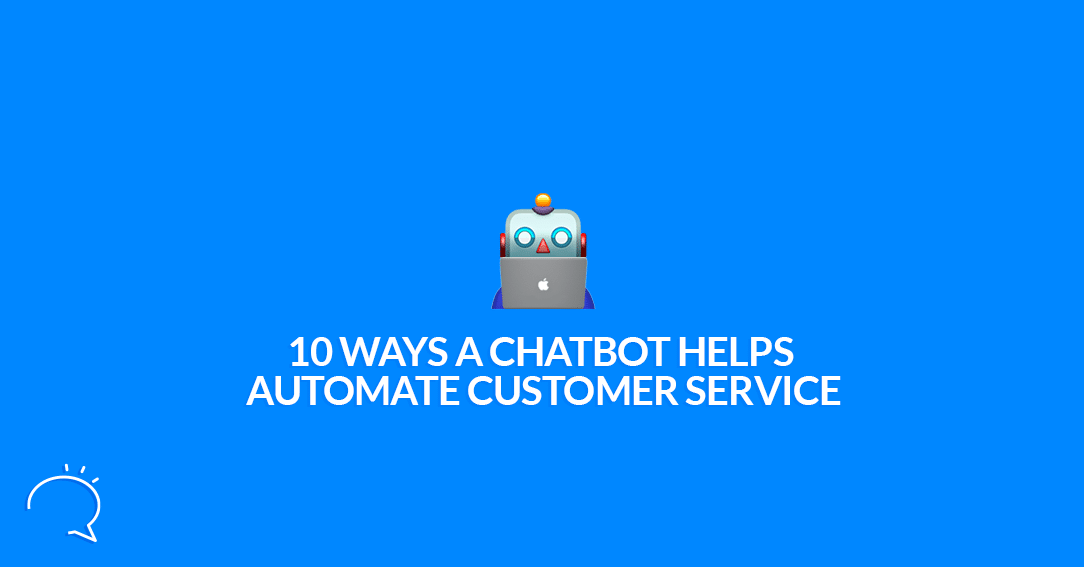Most companies have a customer service department to handle all of the inquiries that come in. And while that’s great for customers, it can be a bit overwhelming for those who answer the phones and emails. That’s why businesses look for ways to automate their customer service. Not only do they have to deal with the sheer volume of incoming messages, but they also need to make sure everything is handled as quickly as possible. That’s why chatbots are often employed as an alternative means of managing customer requests.
Chatbots are an increasingly popular solution to the problem of customer service overload. Companies like Walmart, Sears, and KLM Royal Dutch Airlines have already incorporated chatbots into their customer service practices. The benefits of chatbots are apparent: for one thing, they can handle a greater volume of requests than any human customer service agent.
Why Should You Want a Chatbot to Automate Customer Service?
Indeed, chatbots might not handle every kind of customer request, but many of the most common requests are simple enough for a chatbot to do. That means your company is no longer stuck with one option when it comes to handling customer service. They can answer routine questions. No matter how intricate or complicated your website is, there will always be basic questions people have about your products or services.
Think about it: if your company serves hundreds of thousands of customers at once, it’s impossible to manage everything yourself. Plus, you need all the time you can get to focus on strategic initiatives that can truly make a difference for your company. That’s where the benefits of chatbots come in.
Here are 10 ways a chatbot can help automate your customer service:
Chatbots help with your onboarding process
Chatbots can help onboard new customers and employees. Bots can let them know what’s happening in the chatbot on Messenger, answer any questions they might have, and even send them tips on how to get the most out of their experience. As soon as users type something in the chat window, chatbots supply answers instantly instead of prolonging frustration for new customers and employees. Onboarding new clients is great because it saves you time and money. While it still helps you build stronger relationships.
Chatbots don’t need coffee breaks, sick days, or paid vacation. This means the onboarding process is live 24/7. Customers and employees don’t have to wait for a human to get onboarded. Chatbots help keep you organized during the onboarding process by following up with customers when they leave the onboarding process. Plus, chatbots can help you know when to send them welcome messages and schedule meetings with humans.
Automate Frequently asked questions (FAQs)
Automate your FAQs with a chatbot and avoid wasting time with repetitive questions. Yes, instead of getting frustrated and stressed because you feel the need to directly answer customer questions or requests, let your chatbot do the work for you. Have your chatbot automation trigger the right flows based on keywords customers and prospects put in. Chatbots can help manage support chats, route tickets to the right agent, and automate responses. But by automating your chatbot to send answers based on your customers’ questions, you conversationally promote self-service. Which pretty much deals with 80% of all support questions.
Studies show that 9 out of 10 customers are interested in self-service options when they need help with something. Not surprising; however, most companies are still struggling to implement effective self-service channels despite this demand. While savvy entrepreneurs know they can find this in chatbots already.
Look, if you are annoyed with the exact tickets coming in every week or month that are not critical to your business, then use a chatbot to automate your frequently asked questions; it will save you and your team a bunch of time. And you’ll be able to increase the quality of support for people who do need human attention.
Advanced Bot Routing to the Right Person
Most customers are used to receiving their answer in 4 seconds or less. It’s almost impossible to cater to this expectation without any means of automation. Chatbots can be deployed quickly and scaled up to meet demand. Whenever an issue comes in that does need human attention, a chatbot can route it to the right team and prevent it from becoming overloaded. Do this, and customer satisfaction increases significantly. Customers don’t get frustrated because they get their answers promptly; they are also being routed to the person in question who can solve their problem. As I mentioned before, customers expect a response within 4 seconds.
Keeping databases up to date
Chatbots help automate customer service by keeping databases up to date. Each time a customer makes an inquiry, the chatbot updates the current status of each issue. As a result, the bot can be programmed, so it knows precisely what answer to give customers depending on the situation. Of course, if it is not sure of the answer, it will automatically forward the question or query to a human operator to handle.
By using chatbots to keep databases up to date instead of a team of humans, businesses save time and money. Of course, chatbots do keep databases updated at scale too. Plus, chatbots should work well with any CRM system; whenever you generate a lead, make sure it sends the lead information over to the CRM system you hooked up to your chatbot.
According to a recent report in Forbes, more and more companies use chatbots to send out automated alerts when certain items need attention. Over at Clepher, we do the same thing. Whenever one of our customers needs help, we have our chatbot send out an email, and a notification on Slack, and Messenger, to all the agents currently working.
Reducing the volume of customer inquiries
Chatbots help minimize customer inquiries. With a chatbot, support agents can answer basic questions without the need for a live agent. Chatbots can also guide customers to accurate answers if they cannot find what they are looking for on their own. In fact, a study by Northstar Research found that chatbots can help reduce the volume of customer inquiries up to 80%. Customers receive answers more quickly, and they are also more satisfied with the answers they receive. Providing accurate answers faster can help companies reduce operating costs.
Chatbots help Identify and predict potential problems.
A chatbot monitors chats and flags issues that may be of concern. It can detect potential problems, such as customers getting stuck in a dialogue loop or unexpected responses to specific questions, and correct them before they ever get reported. When customer-service reps can’t identify the source of a problem, more advanced chatbots use deep learning to mine data collected from chats. It surfaces potential issues and suggests fixes by sharing them with human customer service reps. Chatbots also provide alerts when customers show signs of frustration, so agents can handle the interaction more efficiently.
Understanding your customers
Chatbots help you grasp your customers and know what they want. You know what they say, “know your customer, and you will always have a successful business.” You can use your chatbot to gather feedback from your customers. And by using this feedback, you can create new content and products that fit your customers. Bots help gather information about their customers and clients, like what they love or don’t love, which product they prefer, etc. This data helps marketing people gather insights on their customers and build better outcomes for them.
Ensuring consistent, high-quality service across all channels
It’s a challenge for most companies. Customers use more channels to seek support, making it difficult for customer service teams to meet their needs. Luckily, a chatbot can come to the rescue. Next to answering simple questions automatically, they can be programmed to deliver a consistent, high-quality service. Chatbots monitor conversations and bring the most critical customer requests to a human agent in various formats, including emails alerts. Plus, chatbots have been known to identify issues before they escalate. When done right, chatbots can help improve your customers’ experience across all customer touchpoints. So, if you want to retain your customers and drive more revenue through better service, consider adding a chatbot to your business strategy.
Streamlining the early stages of the sales process
Chatbots can streamline the sales process by simplifying the lead qualification process. Early-stage leads can be automatically filtered based on their fit to your ideal prospect profile and then passed to a salesperson for real-time follow-up using chatbots or instant messages. By having a chatbot do the heavy lifting, you again are saving money on manpower costs. According to research from McKinsey Global Institute, the average cost of providing service across all industries is $0.50 per minute. Chatbots can provide service at a fraction of that cost while removing any chance for human error or bias that may come into play during traditional phone conversations. The result? You can reduce your customer service costs by a minimum of 20% while increasing end-customer satisfaction and automating your sales process. That’s huge!
Handling requests that do not need human intervention
A chatbot can handle support without humans; they do this by using a set of rules. In some cases, this is easier for the customers, especially since the chatbot’s “human” responses can sometimes be tongue-in-cheek humor or phrases from pop culture. Humans have to be careful about communicating with customers, so they don’t appear rude or unhelpful. A chatbot can skip the step of carefully crafting responses to provide more efficient customer service.
It depends on the chatbot technology, but it is possible to handle some of them without human intervention. For example, web-based chatbots can detect if a user is present on the website and can initiate a chat or even perform more complex tasks like booking a hotel room. If a chatbot is offering customer service, it can provide more personalized or relevant information to the individual. For example, if you call an airline for help with a lost bag, they may have automated systems to handle this situation by looking up your ticket number and providing general guidance on getting the bag back.
Final Thoughts on Automating your Customer Service with Bots
Chatbots are an integral part of the customer service process. In this blog, we’ve outlined 10 ways a chatbot can help streamline your business and improve its efficiency by automating specific tasks. From improving routing to helping with FAQs, bots are quickly becoming essential for any company looking to increase their bottom line while simultaneously providing an excellent customer service experience. If you want more information on how Chatbots can work for your small or medium-sized enterprise, reach out! Our chatbot and Clepher team are happy to answer any questions you have.
And when you’re just too excited to and want to get started, try Clepher RISK-FREE today; there’s a $300 discount up for grabs today’s special.
Related Posts



